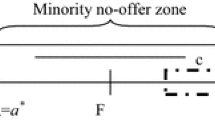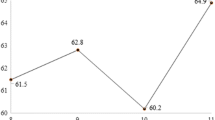Abstract
This paper develops and tests a theory of voting and abstaining on Congressional roll calls. The theoretical model assumes that the voting behavior of legislators is oriented toward reelection, and that constituents vote retrospectively. Among the predictions of the theory are that supporters of a program are more likely to abstain than opponents, that conflicted legislators are more likely to vote on the losing side (but will abstain when the vote is very close), and that indifferent legislators will abstain when votes are not close but trade their votes when the outcome is uncertain. The empirical test is based on a series of votes on appropriations for the Clinch River Breeder Reactor from 1975 to 1982. We estimate a nested logit model of, first, the probability of voting for Clinch River, and second, the probability of abstaining from the vote, conditional on preferences regarding the program. All of the empirical results are consistent with the theoretical predictions, and most are statistically significant by conventional standards. The implication is that the abstention decision, as well as yes or no votes, can be purposive, and that the pattern of abstentions is not random among supporters and opponents.
Similar content being viewed by others
References
Cohen, Linda R., and Roger G. Noll (1991).The Technology Pork Barrel. Washington: Brookings Institution.
Downs, Anthony (1957).An Economic Theory of Democracy. New York: Harper.
Fenno, Richard F., Jr. (1978).Home Style: House Members in their Districts. Boston: Little, Brown.
Ferejohn, John A., and Morris P. Fiorina (1975). The paradox of not voting: A decision theoretic analysis.American Political Science Review 69: 920–925.
Fiorina, Morris P. (1974).Representatives, Roll Calls, and Constituencies. Lexington, MA: Lexington Books.
Fiorina, Morris P., and Kenneth A. Shepsle (forthcoming). Negative voting: An explanation based on principal-agent theory. InInformation and Democratic Processes. John Ferejohn and James Kuklinski (eds.). Urbana: University of Illinois Press.
Garvey, Gerald (1966). The theory of party equilibria.American Political Science Review 60: 29–38.
Glazer, Amihai, and Bernie Grofman (1989). Why representatives are ideologists though voters are not.Public Choice 61: 29–39.
Ledyard, John O. (1984). The pure theory of large two-candidate elections.Public Choice 44: 7–41.
Mayhew, David R. (1974).Congress: The Electoral Connection. New Haven: Yale University Press.
Niemi, R. M. (1976). Costs of voting and non-voting.Public Choice 27: 115–120.
Palfrey, Thomas R., and Howard Rosenthal (1984). A strategic calculus of voting.Public Choice 41: 7–53.
Reid, T. R. (1980).Congressional Odyssey: The Saga of a Senate Bill. San Francisco: W. H. Freeman.
Riker, William, and Peter Ordeshook (1968). A theory of the calculus of voting.American Political Science Review 52(1): 25–42.
Uhlaner, Carole (1989). Rational turnout: The neglected role of groups.American Journal of Political Science 33(2): 390–422.
Author information
Authors and Affiliations
Additional information
The authors gratefully acknowledge research support from the Brookings Institution and the University of Michigan School of Law, and useful comments on an earlier draft by Randall Calvert, Morris Fiorina, Rodney Fort, Amihai Glazer, Keith Krehbiel, Thomas Romer, Kenneth Shepsle, Rodney Smith, Barry Weingast, the UCI Public Choice Study Group, and the Hoover Workshop on Collective Choice.
Rights and permissions
About this article
Cite this article
Cohen, L.R., Noll, R.G. How to vote, whether to vote: Strategies for voting and abstaining on congressional roll calls. Polit Behav 13, 97–127 (1991). https://doi.org/10.1007/BF00992292
Issue Date:
DOI: https://doi.org/10.1007/BF00992292




